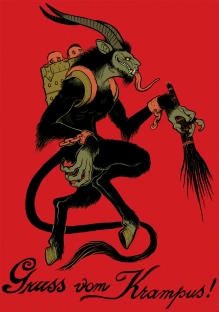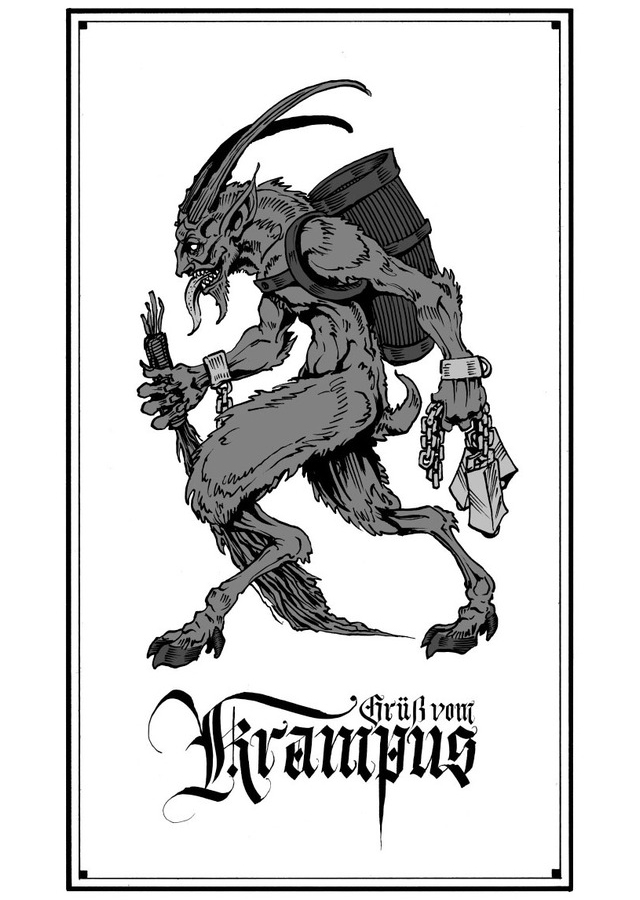 Much like Japan with the Teke Teke, the attitude towards parenting in Germany appears to be somewhat devil-may-care; quite literally when it comes to Krampus, a horrifying demon who carries a bundle of birch twigs and threatens German children with painful ass-beatings if they misbehave. He’s the marginally less cheerful companion of Ol’ Saint Nick and, as firm proof of Santa’s superior delegation skills, he focuses on punishing the naughty children while Santa can kick back and chill with the good kids. These punishments can be anything from being threatened with the birch rod to being carted off to Hell; so be good or Krampus will take you on a one-way joyride to the underworld.
Much like Japan with the Teke Teke, the attitude towards parenting in Germany appears to be somewhat devil-may-care; quite literally when it comes to Krampus, a horrifying demon who carries a bundle of birch twigs and threatens German children with painful ass-beatings if they misbehave. He’s the marginally less cheerful companion of Ol’ Saint Nick and, as firm proof of Santa’s superior delegation skills, he focuses on punishing the naughty children while Santa can kick back and chill with the good kids. These punishments can be anything from being threatened with the birch rod to being carted off to Hell; so be good or Krampus will take you on a one-way joyride to the underworld.
In most Alpine German-speaking parts of Europe, Krampus features as one of the Companions of Saint Nicholas, alongside a blackamoor who kidnaps children and squirrels them away to mid-12th century Moorish Spain and a Gandalf lookalike, among others. Throughout the 1930s, 40s, and 50s his image was largely banned, as were celebrations involving him, but he appeared to enjoy a resurgence in popularity towards the end of the 20th century. Evidently German children had started acting out again and perhaps, dare I say it, even having fun, so it was time to wheel out the birch-wielding goatman to whip them all back into submission. An on-going debate still rages in Austria as to whether Krampus is appropriate for children. You know, because he’s a festive representation of the devil and all that.
And never is this debate more heated than on the night before December 6th, or the Feast of St. Nicholas, known to some as Krampusnacht or “Krampus Night”. On this night, locals don their friendly, furry Krampus costumes and visit children’s homes to remind them that a horrifically scarred ass awaits them if they don’t amend their mischievous ways. Our cheeky devil is sometimes accompanied by Saint Nicholas on these occasions, who dispenses lovely gifts to good children, while Krampus provides naughty children with only coal and bundles of birch twigs known as ruten. So, if you’re low on kindling on the run-up to Christmas, just push over a few old people and Krampus should show up at your door with ample supplies.

Yet this is nothing compared to the terrifying Krampuslauf or “Krampus Run”, where local men get stinking drunk before dressing up as Krampus and chasing unwary passers-by. It is customary to offer these extreme cosplayers a relaxing glass of schnapps, because nothing calms an alcohol-fuelled demon down like the promise of sweet peach liquor. During these horrifying endurance races, the merry Krampus is sometimes accompanied by perchten; women dressed as wild pagan beasts with rotting animal skulls for heads. And we wonder why our Germanic cousins grow up to be so serious.
During the Christmas season, people exchange holiday greeting cards known as Krampuskarten, which each depict delightful images of Krampus beating, kidnapping, or eating young children. And, just when children thought they were safe for the rest of the year, in some places such as Styria, birch bundles are painted gold and displayed in the house year-round as a constant reminder of his oppressive presence.
Appearance
 Although there are some minor variations in depictions of Krampus, most share several common physical features. He is covered in black or brown fur, usually that of a goat, ram, or bear, and has the horns of a goat or a ram on his head. He stands upright and has the facial features of a man, although he has cloven hooves instead of feet and a distinctively long, pointed tongue that constantly lolls out of his mouth. Kind of like a dog sticking its head out of a car, only with more general hatred for mankind and less whimsy.
Although there are some minor variations in depictions of Krampus, most share several common physical features. He is covered in black or brown fur, usually that of a goat, ram, or bear, and has the horns of a goat or a ram on his head. He stands upright and has the facial features of a man, although he has cloven hooves instead of feet and a distinctively long, pointed tongue that constantly lolls out of his mouth. Kind of like a dog sticking its head out of a car, only with more general hatred for mankind and less whimsy.
He is sometimes depicted carrying chains or wearing shackles on his wrists, which symbolises his enslavement to Saint Nicholas, and he loudly thrashes these chains for effect. More often he is shown bedecked with charming bells and simply won’t be seen without his characteristic bundle of birch twigs or, as he likes to call them, the “Ass Swatter”. The bells are designed to warn children of his impending approach, while the birch rod serves to remind them why they should have ran away after hearing the bells. He sometimes appears with a sack or washtub strapped to his back, which he uses to cart off naughty children before drowning them, eating them, or taking them to Hell.
Origins
Krampus’ name is derived from the German word “krampen”, which means “claw”, and he is thought to be the son of Hel from Norse mythology. For those who don’t know, Hel was the ruler of Helheim (the Norse realm of the dead) who had the upper body of a living woman and the lower body of a corpse. So perhaps not the most functional upbringing. Depending on the story, Krampus was either enslaved by Saint Nicholas and was forced to do his bidding, or decided to work for Saint Nick of his own freewill. It seems the repression hit Hell pretty hard, and what’s an out-of-work demon to do?

 Though the Krampus mythos is now part of the Christmas canon, he is largely thought to have pre-Christian origins. Anthropologist Maurice Bruce posits that he was based on the legendary Horned God of the Witches, as his bundle of birch twigs has deeply pagan origins. Similarly John J. Honigmann attests to the “heathen” elements of Krampus’ character and argues that he was once a pagan creature who was eventually assimilated into Christian tradition.
Though the Krampus mythos is now part of the Christmas canon, he is largely thought to have pre-Christian origins. Anthropologist Maurice Bruce posits that he was based on the legendary Horned God of the Witches, as his bundle of birch twigs has deeply pagan origins. Similarly John J. Honigmann attests to the “heathen” elements of Krampus’ character and argues that he was once a pagan creature who was eventually assimilated into Christian tradition.
Modern-Day Usage
Krampus is not widely known outside of Europe but his popularity is growing as a horrifying alternative to the traditionally merry, consumerist Christmas that we have become accustomed to. In light of that fact, here are a few references to our festive furry friend:
- Since the 19th century, Europeans have happily exchanged Krampuskarten featuring images of Krampus, as well as humorous rhymes or poems. Originally he was portrayed as a menacing character, looming over unsuspecting children or lecherously chasing buxom women, but nowadays more modern versions employ a “cuter” Krampus in an attempt to improve his public image.

- The 2015 horror-comedy Krampus , directed by Michael Dougherty of Trick R’ Treat fame, is based around a dysfunctional family who are attacked by Krampus.
- An indie horror film called Krampus: The Christmas Devil was released in 2013 and revolves around a detective searching for missing children.
- Krampus features in the episode of American Dad entitled “Minstrel Krampus”, where it transpires that he was in fact the real hero of Christmas after he is murdered by Santa Claus.
- In the children’s TV show Scooby Doo: Mystery Incorporated, the Krampus features as an antagonist to our hapless, mystery-solving heroes.
- On an episode of the political satire show The Colbert Report, Stephen decides to join forces with the Krampus in order to fight the “War on Christmas” but is swiftly whipped and then threatened by the demon himself.
- A Christmas episode of the supernatural show Grimm featured the Krampus as a humanoid ram dressed in a Santa suit. In the episode, as in folklore, he kidnaps naughty children but instead leaves behind coal in their wake.
- Artists Brian Joines and Dean Kotz created a five-issue comic book series known as Krampus, with Krampus as the main character.
- Let’s Kill Krampus is a card/role-playing game where you can either play as Krampus or as one of eight children. As the former you attempt to eat all of the children, while as the latter your aim is to ultimately kill Krampus.
- Believe it or not, there is a surprising amount of erotic fiction about Krampus, including A Kiss From Krampus by Red Hanner, Punished By The Krampus by Sapphire Del Ray, and Christmas Spirit by Alise Bell.
- There is an Italian folk-metal band called Krampus. Yes, you heard me, an Italian folk-metal band.
- In the indie video game Don’t Starve, the Krampus will appear and steal the player’s items if the player has been “naughty”, i.e. if they’ve been killing too many non-aggressive animals such as rabbits or beefalo.
- In the strategy-based video game Medieval II: Total War, there is a mod where Krampus is included among Santa’s units.
- During the Frost Moon event of the video game Terraria, Krampus features as an enemy.

Want to support us so that we can continue creating great horror content? Then sign up to our Patreon.

This is scary.
Regards,
http://www.reloadfood.com (A Growing Teenager Diary Malaysia)
LikeLike
[…] until next week. If you really need to get your fix, why not go back and read our post on good old Krampus […]
LikeLike